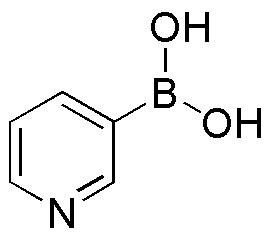Pyridine-3-boronic acid is widely utilized in research focused on:
- Synthetic Chemistry: This compound serves as a crucial building block in the synthesis of various pharmaceuticals and agrochemicals, enabling the creation of complex molecules with enhanced biological activity.
- Cross-Coupling Reactions: It is commonly used in Suzuki-Miyaura coupling reactions, which are essential for forming carbon-carbon bonds, making it valuable in developing new materials and fine chemicals.
- Bioconjugation: Pyridine-3-boronic acid can be employed in bioconjugation techniques, allowing researchers to attach biomolecules to surfaces or other molecules, which is beneficial in drug delivery and diagnostic applications.
- Fluorescent Probes: This compound is utilized in the design of fluorescent probes for detecting specific biomolecules, aiding in biological research and medical diagnostics.
- Environmental Applications: It can be used in the development of sensors for detecting pollutants, contributing to environmental monitoring and protection efforts.
General Information
Properties
Safety and Regulations
Applications
Pyridine-3-boronic acid is widely utilized in research focused on:
- Synthetic Chemistry: This compound serves as a crucial building block in the synthesis of various pharmaceuticals and agrochemicals, enabling the creation of complex molecules with enhanced biological activity.
- Cross-Coupling Reactions: It is commonly used in Suzuki-Miyaura coupling reactions, which are essential for forming carbon-carbon bonds, making it valuable in developing new materials and fine chemicals.
- Bioconjugation: Pyridine-3-boronic acid can be employed in bioconjugation techniques, allowing researchers to attach biomolecules to surfaces or other molecules, which is beneficial in drug delivery and diagnostic applications.
- Fluorescent Probes: This compound is utilized in the design of fluorescent probes for detecting specific biomolecules, aiding in biological research and medical diagnostics.
- Environmental Applications: It can be used in the development of sensors for detecting pollutants, contributing to environmental monitoring and protection efforts.
Documents
Safety Data Sheets (SDS)
The SDS provides comprehensive safety information on handling, storage, and disposal of the product.
Product Specification (PS)
The PS provides a comprehensive breakdown of the product’s properties, including chemical composition, physical state, purity, and storage requirements. It also details acceptable quality ranges and the product's intended applications.
Certificates of Analysis (COA)
Search for Certificates of Analysis (COA) by entering the products Lot Number. Lot and Batch Numbers can be found on a product’s label following the words ‘Lot’ or ‘Batch’.
*Catalog Number
*Lot Number
Certificates Of Origin (COO)
This COO confirms the country where the product was manufactured, and also details the materials and components used in it and whether it is derived from natural, synthetic, or other specific sources. This certificate may be required for customs, trade, and regulatory compliance.
*Catalog Number
*Lot Number
Safety Data Sheets (SDS)
The SDS provides comprehensive safety information on handling, storage, and disposal of the product.
DownloadProduct Specification (PS)
The PS provides a comprehensive breakdown of the product’s properties, including chemical composition, physical state, purity, and storage requirements. It also details acceptable quality ranges and the product's intended applications.
DownloadCertificates of Analysis (COA)
Search for Certificates of Analysis (COA) by entering the products Lot Number. Lot and Batch Numbers can be found on a product’s label following the words ‘Lot’ or ‘Batch’.
*Catalog Number
*Lot Number
Certificates Of Origin (COO)
This COO confirms the country where the product was manufactured, and also details the materials and components used in it and whether it is derived from natural, synthetic, or other specific sources. This certificate may be required for customs, trade, and regulatory compliance.


